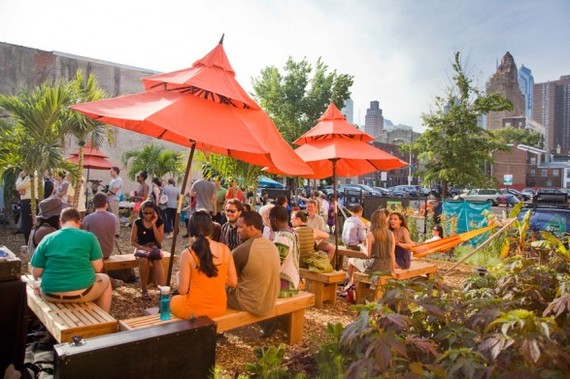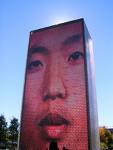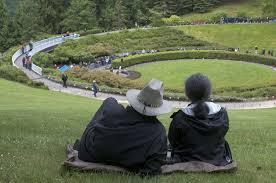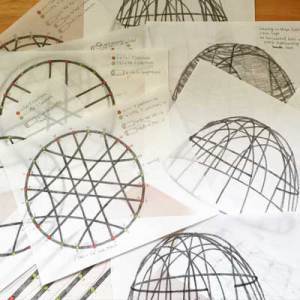What if you encountered an interactive art installation when you walked into a conference, park, building lobby or other semi-public place? Better yet, what if it was designed to spark your imagination and spur conversations with others nearby?
That's what happened when TEDx group organizers met at their annual TEDActive meeting in Whistler, British Columbia in March. They discovered a Dome, dubbed The Act of Stillness where they were invited to, "Slow down, pause, be still. Dare to free your ideas and let your truths emerge," and then post notes of their creative experience on the Dome's walls for others to see.
Consequently, many of the subsequent conversations among attendees started at a deeper level. Zappos founder Tony Hsieh calls such unexpected and often productive encounters collisions.
The installation was designed by TEDx Artist-in-Residence program co-creator, Rebecca Shapiro whose earlier interactive artwork was displayed at the Portland, Oregon airport. The team wrote a guide for TEDx groups around the world to use in partnering with local artists to create art that reflects their conference theme and spurs greater engagement among attendees. TED is encouraging the TEDx groups to exchange their creations so they can learn from each other.
What if the state chapters of an association similarly collaborated to create interactive art installations at their conferences? Imagine what associations as diverse as the American Hospital Association and the National Recreation and Park Association hosted a similar program? They might inspire attendees to co-create ways to enhance the on-site experience of those they seek to serve. Further they could build bonds between attendees for future collaboration around sweet spots of shared interest they discovered
Find Inspiration for Your Bond-Building Interactive Art Creation
Here are some examples of public art that pulls people closer -- and that might prime the pump for you to inspire your colleagues to co-create your own, pop-up or permanent collision-spurring art installation.

• Outdoor installations began popping up in Philadelphia neighborhoods on May first, including van Gogh's "Sunflowers" along a bike path, and Claude Monet's "The Japanese Footbridge" and the "Water Lily Pool, Giverny" in the middle of a park, thanks to a collaboration between the Knight Foundation, the Philadelphia Museum of Art and local residents. In that tradition the Pennsylvania Horticultural Society creates convivial Pop Up Gardens each year.
• Want to see somber-looking pedestrians suddenly break out in smiles, start posing with each other - even laying on the pavement together, looking up and taking photos in a very public place? Like to see yourself literally in many different ways? Then visit Anish Kapoor's play-inducing Cloud Gate. Across the wide Michigan Avenue from the Chicago Architectural Foundation, where our tour gathered you see the magnificent Millennium Park. Three imaginative structures were designed to be tourist magnets. All are moving from me to we-centric art, literally moving people to interact, sometimes even with strangers. Frank Gehry's Pritzker bandshell was expected to be the top attraction, yet Cloud Gate and the Crown Fountain are the real crowd-involvers.
Looking like a gigantic liquid mercury bean, Cloud Gate is an elliptical, mirror-like sculpture. It that looms large yet is so inviting. Walking up to it, under and around it to see shape shifting portraits of yourself, your friends, nearby strangers and many sides of the sky and buildings around you. People touch it and join in making faces at it. Often they turn to look back at "The Bean" from different directions. That feeling of joy extends to the proud craft people involved in its making.

• Nearby, Jaume Plensa's Crown Fountain is actually two 50-foot high towers, separated by a 48-foot wide pond of water that flows over an edge at sidewalk level. But the spectacular action happens in four short acts. First, you see led light-generated Chicagoan's face appears on each tower. Moments later that person purses her or his mouth. Then, in modern gargoyle fashion, and a spout of water spews out. For a finale before the next 12-minute show starts with the face of another Chicagoan, a wall of water falls down both towers. (Over 1,000 photos of other Chicagoans are in this free show.) 
• Two other large public 'sculptures" that fall into the interactive category because they draw people closer, albeit via a much different emotion - to viscerally remind us of a war. One is Maya Lin's once controversial, deeply moving Vietnam Memorial, dubbed "the wall that heals," that spawned a traveling half-size replica.

For Oregonians, an especially touching, if lesser-known, monument also involves people in walking through the experience. Like Lin's monument, Walker Macy's wall,Vietnam Veterans of Oregon Memorial, is made of polished, black granite. See the names of Oregonians who died. Yet, as you walk up along this wall and follow it around a curve, the wall rises higher as the number of war deaths rose over time and then lower as the end nears. Along the bottom of the wall, if memory serves me right, you see listed, one after the other, significant events in that faraway war. Right above each war event you find an event that happened in Oregon at the same time, for example our Portland Rose Festival. The juxtaposition is appropriately jarring - as it would be if we build the same kind of wall, one day, to remind us of the effects the wars
in Afghanistan and Iraq. Others created their own monuments. Hint: Interactive art that evokes us to move literally deepens our emotional responses.
What other examples of interactive art have you discovered or created? What "what if" dream scenario can you concoct that could spur greater interaction between those who matter to you? Share it with us in your comment here.


